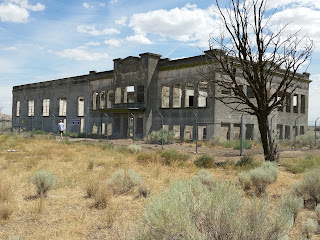2,573 miles
July 19 – This
town shared the history of its region, from Algonquin tribes and Iroquois
raiders to French voyageur fur traders, loggers, struggling farmers, and then
city folks bringing an increase in summer cottages and outdoor recreation along
the river.
In the year 1902, the first
hydroelectric dam was built on the Ottawa River to modernize the lives of the
people.
In September
1944, during World War II, some Government men came to the area and spent the
next week and a half studying the river depths and currents. Soon after, the government announced that His
Majesty the King (George VI of England & Canada, etc.) had appropriated the
nearby township of Buchanan for a vital wartime project. Residents learned that they were being
expropriated from their land, and they left town forever the following year. Most of the residents did not have the means
to start again from scratch, so they dismantled their buildings and transported
them elsewhere. Today, many of the
historic remains of the relocated residents lie quietly within the boundaries
of the nuclear research facility.
 |
| used & abandoned Hanford High School |
This story
reminds me of the history of my own birthplace, Hanford, Washington. To build the atomic bomb factory to end World
War II, the US federal government shut down the agricultural town of Hanford
and sent its residents away. Residents
were given a 30-day eviction notice on March 9, 1943. Most buildings were destroyed, except the
high school, which was used during the war as an office building. I was born on the military base on the nuclear
reservation after the war ended, but I claim the former town of Hanford as my
birthplace.
 |
| CANDU reactor design |
Since the
1950s, when nuclear energy was developed for peace-time electric power
generation, this Ontario town has been the home to the Nuclear Power
Demonstration, the first Canadian nuclear power reactor. The NPD was the prototype and proving ground
for research and development that led to commercial application of the Canadian
“CANDU” system for generating electric power from a nuclear plant. The
CANDU acronym refers to its Canadian-developed design using heavy water (deuterium-oxide)
and uranium fuel. CANDU reactors were
first developed in the late 1950s and 1960s by a partnership between Atomic
Energy of Canada Limited (AECL), the Hydro-Electric Power Commission of
Ontario, Canadian General Electric, and other companies. All power reactors built in Canada are of the
CANDU type.
 |
| CANDU workers in hazmat suits |
Many of the 2,800
residents of the township are employees of the nuclear reactor facility. They are scientists and engineers and hazardous
materials technicians.
In the year
2000, the Town of Laurentian Hills was created by merging the administration of
several depopulated towns in the area.
It was then named not for any vestige of local history but for the
scenic hills visible across the river in Quebec. At least, those hills are visible from the
nicer houses on the banks of the Ottawa River.
 |
| community hockey rink & fun center |
The center
of town consists of a snowplow garage, a municipal building, a fire station,
and an outdoor hockey rink. In the 6-month
season of non-winter, such as the day Google Street Views took their pictures,
the hockey rink looks neglected and derelict.
But there are signs of lively community enjoyment: a meeting facility,
snack concession stand, children’s play structure, plus basketball hoops for
non-ice season practice.
As I “drove”
around the local roads via Google Street Views, I saw evidence of people’s
preparation for fierce winters. Almost
every house had an open woodshed full of neatly stacked firewood.
info: Wikipedia.com
Algonquins
to Atoms Along the Ottawa: http://www.nuclearfaq.ca/ottawa.htm
images: Google Images




Hello Jenny,
ReplyDeleteI enjoyed your article. My name is John Wallace Cheeseman. You posted a picture of my grandfather's old cottage. Our family once owned 100 acres of water-front property along the beach of Baptism Pt. that was expropriated in 1944 to build the nuclear facility. Send me your email address so we can talk further about this subject. Thanks. kjcheese@bellaliant.net
I am pleased that you found the article & photo! It seems that I did grasp the phases of history that your family's story represents, from woodland homestead to nuclear power plant. I will contact you, too, by e-mail.
ReplyDelete